First photos through the 10 inch telescope
Sections in this page
Clear evening skies are rare this summer (2009) in northern Britain. One occurred on 15th August and I grabbed the chance to start trying to photograph through my new telescope. It was breezy that night. Also I did not attempt to align the polar axis of the mount. For both of those reasons the star images are larger and less circular than I expect they will be under better conditions. Nevertheless I was delighted to find it quite easy to capture some deep sky objects. My observing site is on the edge of the conurbation of Tyneside, so light pollution is significant. I did not use any kind of filter so I was pleased to discover that my first photos show stars down to at least magnitude 16.5 (1/10,000 of the brightness of the faintest stars visible to the naked eye in an unpolluted sky). That demonstrates the light gathering power of a 10 inch diameter mirror, assisted by the very high ISO sensitivity settings possible in the EOS 5D MkII. As usual I took many photos of each object and combined them in GRIP to reduce noise.
So, the following snaps are far from perfect but to me they represent a very encouraging start.
Later photos are indexed on the next page (see link at bottom, also linked from here).
M13 globular cluster in Hercules
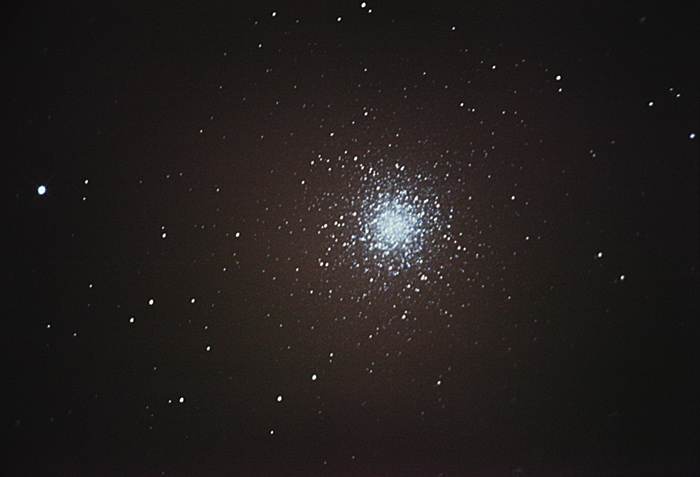
Canon EOS5DMkII 254mm Newtonian @ 2380mm 39 x 10s f/9.4 ISO25600 2009:8:15 22:28:29-22:36:45
Item 13 in Charles Messier's 18th century catalogue of faint fuzzy objects in the sky turned out, in the light of later observations with better instruments, to be a gravitationally bound cluster of around 1 million stars. I had seen many photographs of it in books but my first look at it by eye through the new telescope was a revelation. Due to our atmosphere it twinkles in a most fascinating way. No photograph can possibly show this because photography has to integrate the faint light over an appreciable time (minutes). The eye can catch rapid subtle changes, so the real thing is far more beautiful than the photographs suggest.
Distance: 26,000 light years.
Globular clusters are outside our galaxy (the Milky Way) but bound by gravity to orbit around it. Their distances from us are not very accurately known because they contain few if any of the kinds of stars that are usually used for determining extra-galactic distances. They are generally billions of years old.
M92 globular cluster in Hercules
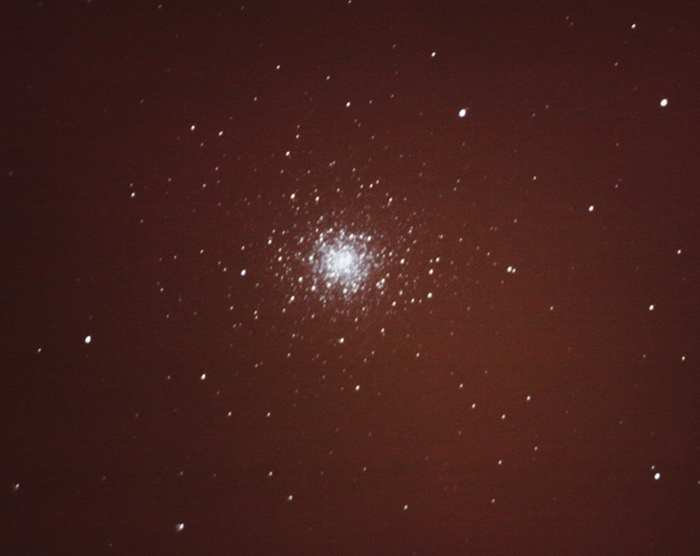
Canon EOS5DMkII 254mm Newtonian @ 2380mm 24 x 10s f/9.4 ISO12800 2009:8:15 22:40:41-22:45:45
A smaller but more distant globular cluster which also happens to be in the constellation of Hercules.
The red glow in the background is of course light pollution.
Distance: 28,000 light years.
M57 planetary nebula in Lyra
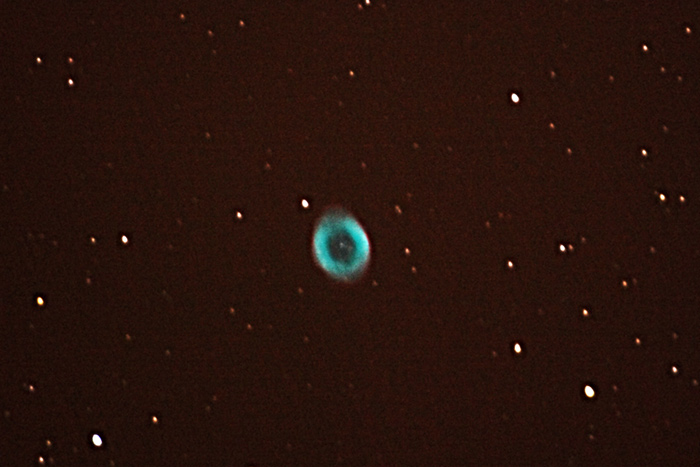
Canon EOS5DMkII 254mm Newtonian @ 2380mm 20 x 10s f/9.4 ISO12800 2009:8:15 22:57:44-23:04:15
A star in the constellation of Lyra has jettisoned a shell of gas which has expanded over many centuries until it appears like this, the well-known ring nebula. The star did not completely blow itself apart, so it can still be seen in the centre of the ring, at magnitude 15.2.
My photo has been processed in GRIP to deconvolve it, taking a star image (41 x 41px) as the point spread function, relaxation factor 0.3, for 4 passes.
One thing that interests me about this image is the colour. I have used no filters, nor adjusted the colour balance in any way, so this may be something like the true colour of the nebula (if that is meaningful). It is impossible to see that visually because the eye loses its colour sensitivity in the dark, particularly for such a faint object (the surface brightness of the nebula is published as 9.4). Through the telescope I only see a slightly greenish shape. I am interested to see the red outline, which is shown in some other photographs.
The nebula emits light because it comprises an ionised gas, excited by radiation from the central star but emitting light at the specific frequencies of atomic transitions of the particular ions, as they fall back from the excited states. For this reason it would be possible to photograph the nebula through a filter that cuts out most light pollution. I have such a filter and plan to try it later.
Distance: 1,400 light years, but not known with certainty. It has been estimated that at that distance it would have taken about 20,000 years for the ring to reach its observed size.
Jupiter and its Galilean satellites
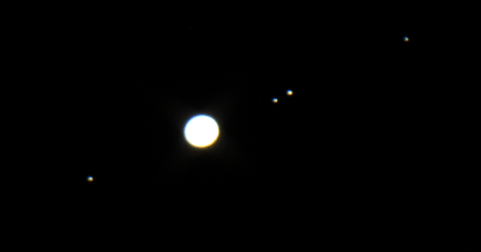
Canon EOS5DMkII 254mm Newtonian @ 2380mm 0.5s f/9.4 ISO1600 2009:8:15 23:31:40
Not a good photo but similar to what Galileo would have seen. Jupiter is currently very low in the sky from here. From left to right the 4 satellites are II Europa, I Io, III Ganymede, IV Callisto.
Core of M31 galaxy in Andromeda
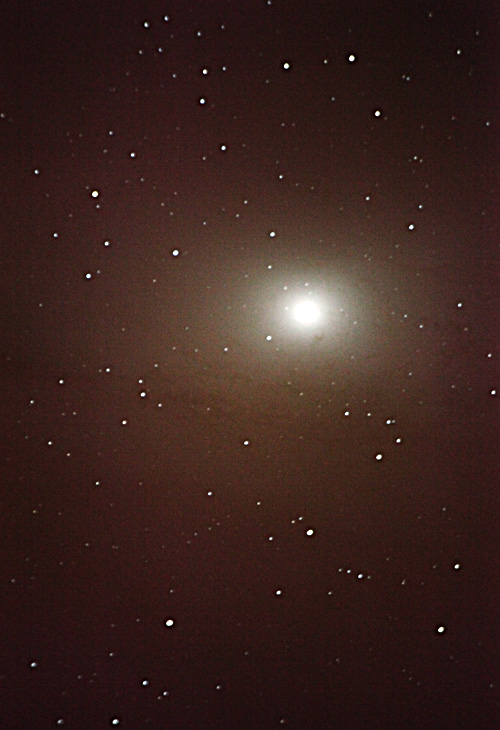
Canon EOS5DMkII 254mm Newtonian @ 2380mm 24 x 10s f/9.4 ISO12800 2009:8:15 23:20:52-23:26:42
Again I am sure I will be able to do better, but this is just the first session with the new scope. As explained on the previous page, the field of view in my camera is 50' x 33', so only the central core of the Andromeda galaxy is captured here. You can see the bands of gas obscuring some of the stars in the galaxy but the individual stars are not resolved.
A later and better photo can be seen here.

